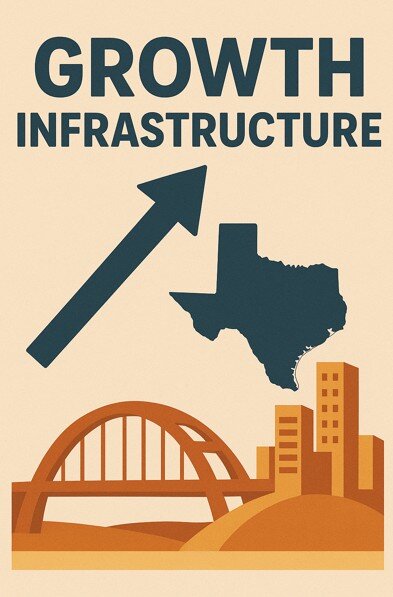
Understanding Texas’s Rapid Growth
Texas has become one of the fastest-growing states in the U.S., drawing in millions of new residents over the past decade. Its appeal lies in a mix of job opportunities, affordable housing (relative to coastal states), and a business-friendly environment. Major metros like Austin, Dallas, Houston, and San Antonio have exploded in population—and with them, once-quiet suburbs like Conroe, Cedar Park, and Pflugerville have transformed into booming residential hubs.
This rapid growth, however, has outpaced the state’s ability to keep up with crucial infrastructure needs, particularly in suburban and exurban areas where development has outstripped long-term planning.
Infrastructure Under Pressure
Water Systems Struggling to Keep Up
In fast-growing suburbs such as Conroe and Magnolia near Houston, water infrastructure has become a major bottleneck. In 2025, both cities had to implement construction moratoriums due to insufficient water capacity. The explosion in housing developments placed unsustainable demands on local utilities that were not designed to serve such a rapidly expanding population.
The strain on water systems is not just about supply—it’s also about distribution and treatment. Without significant upgrades, these areas risk facing water shortages, development delays, or skyrocketing costs to fund emergency fixes.
Roads, Traffic, and Public Transit Bottlenecks
Texas is famous for its wide roads and long commutes, but even these are reaching their limits. The influx of residents means more vehicles on highways and surface streets, leading to worsening congestion in urban fringes. In places like Austin and North Dallas, daily commutes have stretched significantly in the past five years.
Public transit solutions are limited outside core metro areas, and without long-term investment, the transportation burden will only grow worse.
Power Grids and Internet Connectivity Gaps
Many rural and suburban areas still lack the infrastructure to support modern demands for electricity and high-speed internet. In a state already familiar with power grid instability (e.g., the 2021 winter storm crisis), population growth raises serious concerns about energy resilience. At the same time, the digital divide is widening in communities where remote work is growing but broadband is unreliable.
Key Cities and Suburbs Feeling the Strain
Conroe and Magnolia: Water Infrastructure Crisis
Both Conroe and Magnolia exemplify what happens when population growth outpaces utility capacity. Developers in these areas are now required to work closely with municipal utility districts (MUDs) to manage supply concerns. In some cases, entire subdivisions have been paused or canceled.
Austin and San Antonio: Growth vs. Gridlock
Austin’s tech boom has fueled suburban sprawl to the north and east, leading to extreme traffic congestion, especially along I-35. San Antonio faces similar issues as growth spreads outward faster than public infrastructure can scale.
Houston Area: Development Delays and Moratoriums
The greater Houston area continues to dominate in new home construction, but many developers now face stricter permitting processes due to water and drainage issues. Flood mitigation is also a growing concern in light of recent storm events.
Real Estate Impact: Delays, Costs, and Risks
Construction Moratoriums and Permitting Issues
When infrastructure fails to keep up, real estate developers often face moratoriums or increased fees to support upgrades. This causes delays, reduces inventory, and limits affordability—pushing buyers farther out into even less developed areas.
How Infrastructure Delays Affect Home Prices
Limited supply and added development costs often translate into higher home prices. Additionally, properties in areas with known infrastructure challenges may appraise lower or take longer to sell, affecting ROI for investors and homeowners alike.
What Builders and Buyers Need to Know
Builders must now account for utility availability and municipal planning timelines. Homebuyers, meanwhile, should look beyond home prices to consider long-term livability—water access, traffic, and service reliability are key to sustained property value.
Solutions and Investment Plans
Local Government Strategies to Expand Capacity
Cities and counties are starting to respond with long-term investment plans. Bond packages, utility upgrades, and regional development frameworks are in motion across metro areas. Some municipalities are offering incentives for smart growth and density-oriented housing.
Private Sector Infrastructure Initiatives
Some developers are collaborating with private utility companies to fast-track infrastructure builds. Build-to-rent communities often include their own internal water, power, and waste management systems to bypass municipal delays.
Can Texas Grow Sustainably?
Sustainable growth is possible—but it requires intentional planning, regional collaboration, and forward-thinking investment. Without it, Texas risks building more homes than it can support, putting stress on residents, ecosystems, and property markets.
What This Means for Buyers and Investors
For homebuyers, especially those looking in fast-growing suburbs, infrastructure readiness should be a top priority during the search. Ask questions about utility capacity, traffic studies, and future city plans.
Investors should stay informed about regions where moratoriums or supply limitations could delay new builds or reduce resale potential. Conversely, areas with strong infrastructure commitments may offer higher long-term upside.
Final Thoughts: Balancing Growth with Infrastructure Readiness
Texas remains one of the most attractive real estate markets in the U.S., but its success depends on more than population growth alone. Infrastructure is the foundation of livable communities—and when it lags behind, it becomes the hidden cost of growth.
Whether you’re a buyer, builder, or investor, keeping a pulse on infrastructure developments is essential for making smart, future-proof decisions in Texas real estate.